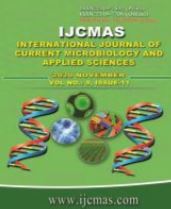


 National Academy of Agricultural Sciences (NAAS)
National Academy of Agricultural Sciences (NAAS)

|
PRINT ISSN : 2319-7692
Online ISSN : 2319-7706 Issues : 12 per year Publisher : Excellent Publishers Email : editorijcmas@gmail.com / submit@ijcmas.com Editor-in-chief: Dr.M.Prakash Index Copernicus ICV 2018: 95.39 NAAS RATING 2020: 5.38 |
In the era of conservation forestry, protection of floral and faunal diversity is important prerequisite. Due to the effective implementation of conservation strategies in the protected areas, growth of faunal population will be in increasing phase which leads to the expansion of home range and territory. The present investigation was conducted to assess the human influence on the corridor between Mudumalai Tiger Reserve and Mukurthi National Park in Tamil Nadu during the period from August 2014 to July 2015.The anthropogenic disturbance level was moderate (0.04 out of 0.08) and habitat linkage was also moderate (0.03 out of 0.06). Regarding area suitability for Tiger habitat, around 12 sq km (8.33 %) of area was highly suitable and around 32 sq km (22.22 %) were not suitable. Naduvatum was maximum respondent (33.33 percent) due to proximate to forest (1 km). Regarding witness about carnivores population, Leopard was witnessed more (41.67 %) than Tiger (38.33 %). With regard to man animal conflict of the study area, results revealed that conflict was increasing year to year from 2013 to 2015 [in 2013 (22 cattle), in 2014 (35 cattle), in 2015 (7 cattle up to June)]. With respect to season February and March month recorded maximum conflicts. With regarding matrix ranking of conflict, livestock depredation was the major problem followed by crop raiding. Regarding carnivores, Leopard was the major conflicting animal (61.90 %) than Tiger (38.10 %). Maximum domestic animals were killed in reserve forest (53.57 %). Regarding collections of fuel wood, the maximum respondent (35.17 %) collected their fuel wood from their surroundings, and with respect to Non Wood Forest Product collection the maximum respondent (47.37 %) collected eucalyptus leaves for extraction of eucalyptu soil. These grid pathways when monitored regularly and given protection from human intervention, protect Tiger population and its expansion in Nilgiri Biosphere Reserve.
 |
 |
 |
 |
 |